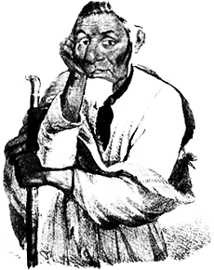Nicolas Perrot
Nicolas Perrot (* around 1642; † August 13, 1717 ) was a French fur trader and explorer in North America. As one of the first whites he came from the northeast to the upper reaches of the Mississippi River .
Through his diplomatic nature and knowledge of some Indian languages, he made a name for himself in several peace missions in the Iroquois Wars.
Life
Perrot was born in Burgundy between 1641 and 1644 , where his father was a senior judicial officer.
Around 1660 he came to New France with the Jesuit mission and traveled to the Great Lakes and in 1665 to what is now Wisconsin . He acquired the friendship of the Indians by exchanging rifles for furs, learned Algonquin and founded a fur trade in 1667 . In 1670 Jean Talon hired him as a translator for Simon-François Daumont de Saint-Lusson's expedition to the Indian peoples of the Odawa and Amikwa between today's Ottawa and Illinois and other tribes on the Upper Lake .
After this expedition he received land in Québec and married Madeleine Raclot, with whom he had six children.

Due to his good relations with the Indian tribes, he took part in a peace mission from Governor Lefebvre de La Barre in 1684 and brought seven chiefs to sign a treaty. He then became the commandant of Bais Des Puants, today's Green Bay (Wisconsin) , but war soon broke out between the Fox, Sioux and Chippewa . After a difficult peace treaty, he traveled to the northern Mississippi , where he built Fort Saint Antoine.
In the spring of 1687, Perrot took part in an expedition to what would later become Detroit when a fire broke out in the Jesuit mission Bais De Puants, which destroyed furs worth 40,000 livres (approx. 500,000 euros). As a result, Perrot was financially ruined and he returned to Montreal , where in 1688 he served as a translator for the governor's negotiations with the Onondaga chief Otreouti , who promised the neutrality of the Onondaga tribes, the Cayugas and the Oneidas.
At the mouth of the Wisconsin River , he built Fort Saint-Pierre in 1689 and continued to act as a peacemaker between the tribes. With Louis de la Porte de Louvigny in 1690 he managed to bring a vital convoy from Montreal to Michilimackinac , although the Iroquois blocked the Ottawa River, and to assure France of the loyalty of some tribes, which stabilized the colonies of New France against the Five Nations of the Iroquois .
In the following years he was instrumental in the discovery and exploration of lead deposits, which he had learned about from chiefs of the Miami .
The now recognized diplomat succeeded in 1695 in getting chiefs of the Miami, Sauk , Menominee , Potawatomi and Fox to take part in negotiations with the governor over the Iraqi wars in Montreal . When he returned west, he was able to contribute to their agreement, but twice almost ended up on the torture stake at the Mascouten and Miami .
Then Perrot settled in his country estate near Bécancour , except in 1701 when he participated in the Great Peace of Montreal . For some time he was plagued by financial problems and he expected the government to pay for his expenses and a pension for his long service. But he was unsuccessful, even in court. Eventually he wrote his memoirs , which became a treasure trove for future historians.
He died on August 13, 1717 at the age of 74 and was buried the following day in the church of Bécancour . Nine of his eleven children survived him; his wife died in 1724.
literature
- Charles Claude Le Roy sieur Bacqueville de la Potherie: Adventures of Nicolas Perrot, 1665–1670. (Contemporary source) full text, p. 72ff. (and previous introduction pp. 69ff.), Northern Illinois University site , Libraries, area: Lincoln / Net
- Thomas J. LaForest: Our French-Canadian Ancestors. Lisi, 1983, ISBN 0-914163-01-9 .
- Robert Perreault: Les familles "Perreault" de la province de Québec, Canada, Volume 1: Le Groupe de Nicolas Perrot et de Madeleine Raclos. 1976
Web links
Individual evidence
- ↑ Musée virtuel , Canada's National Museum of History and Society , animation of his travels, either English or French.
- ^ Daumont de Saint-Lusson, Simon-François . In: Dictionary of Canadian Biography . 24 volumes, 1966–2018. University of Toronto Press, Toronto ( English , French ).
| personal data | |
|---|---|
| SURNAME | Perrot, Nicolas |
| BRIEF DESCRIPTION | French fur trader, explorer and diplomat |
| DATE OF BIRTH | around 1642 |
| DATE OF DEATH | August 13, 1717 |
